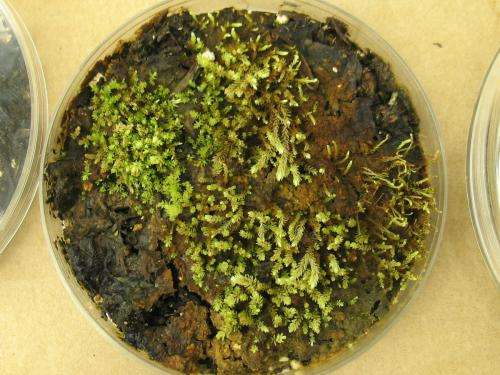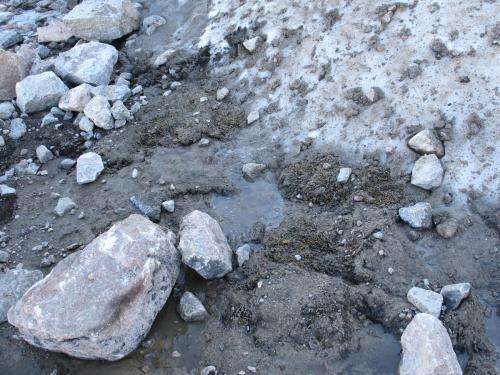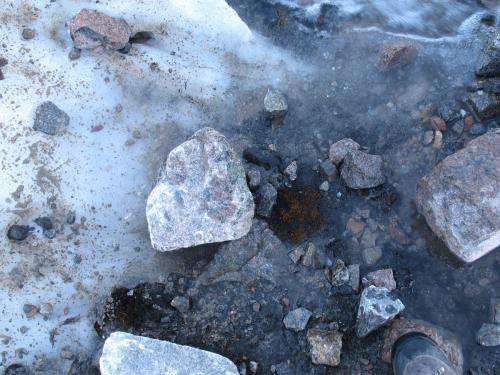May 28, 2013 report
Researchers find 400 year old Ice Age plants in Arctic able to grow anew as glaciers retreat

(Phys.org) —A team of researchers from the University of Alberta led by, Catherine La Farge, has found that mosses and liverworts covered by ice over 400 years ago and now exposed due to glacial melting, are able to start growing again. In their paper published in the journal Proceedings of the National Academy of Sciences, the team describes how carbon dating showed the plants to be from a time just prior to the Little Ice Age.
The research team ventured to the Canadian Arctic Archipelago to see what changes were occurring in the Arctic due to global warming—the Teardrop Glacier on Ellesmere Island in Nunavut, they note, has retreated more than 650 feet over the past several hundred years. Just next to the glacier's edge, the team found some green growth among clumps of exposed dead plant material that had been under the ice for centuries. Intrigued, they collected some samples and brought them back to their lab for study.

The team put 24 cultures in an ideal environment and found that 11 of them began to grow, representing four distinct taxa. The plants, known as bryophytes—moss, lichen, liverworts, etc—don't have vascular tissue to pump fluids, a property that helps them survive in very cold climates. Carbon dating of the samples showed that the plants had been living approximately 400 to 615 years ago—a time just before the Little Ice Age (1550-1850). Byrophytes have another property, called totipotency that allows any cell of the plant to reproduce and grow into a whole new plant.

The findings dispel the common belief that land exposed by melting glaciers becomes populated by new plant growth exclusively via seeds or spores carried by the wind. Instead, some plants lying frozen beneath the ice are apparently able to survive and begin growing again when the environment changes. This suggests that Earth scientists will have to take a new look at models meant to portray how ecosystems recover from glaciers after they retreat.

The researchers note that plants aren't the only type of life being exposed by melting glaciers—cyanobacteria and green terrestrial algae have also been spotted, some of which haven't ever been seen before.
More information: "Regeneration of Little Ice Age bryophytes emerging from a polar glacier with implications of totipotency in extreme environments," by Catherine La Farge, Krista H. Williams, and John H. England. PNAS, 2013. To be available at www.pnas.org/cgi/doi/10.1073/pnas.1304199110
Abstract
Across the Canadian Arctic Archipelago, widespread ice retreat during the 20th century has sharply accelerated since 2004. In Sverdrup Pass, central Ellesmere Island, rapid glacier retreat is exposing intact plant communities whose radiocarbon dates demonstrate entombment during the Little Ice Age (1550–1850 AD). The exhumed bryophyte assemblages have exceptional structural integrity (i.e., setae, stem structures, leaf hair points) and have remarkable species richness (60 of 144 extant taxa in Sverdrup Pass). Although the populations are often discolored (blackened), some have developed green stem apices or lateral branches suggesting in vivo regrowth. To test their biological viability, Little Ice Age populations emerging from the ice margin were collected for in vitro growth experiments. Our results include a unique successful regeneration of subglacial bryophytes following 400 y of ice entombment. This finding demonstrates the totipotent capacity of bryophytes, the ability of a cell to dedifferentiate into a meristematic state (analogous to stem cells) and develop a new plant. In polar ecosystems, regrowth of bryophyte tissue buried by ice for 400 y significantly expands our understanding of their role in recolonization of polar landscapes (past or present). Regeneration of subglacial bryophytes broadens the concept of Ice Age refugia, traditionally confined to survival of land plants to sites above and beyond glacier margins. Our results emphasize the unrecognized resilience of bryophytes, which are commonly overlooked vis-a-vis their contribution to the establishment, colonization, and maintenance of polar terrestrial ecosystems.
Journal information: Proceedings of the National Academy of Sciences
© 2013 Phys.org















